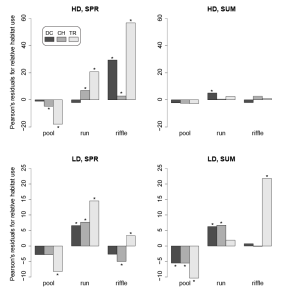Elkins and Grossman 2013 is out. If you have journal access you can grab it from Biological Invasions. If not, drop me a line. This is the first of the papers from my dissertation, I’ve been pretty tied up with post-doccing and writing up those results- look for the other two, soon.
I’m pleased with the way one figure came out, in particular. I used a partial chi-square analysis to see if any of the habitat shifts we observed by the warpaint shiners were significant, since a typical chi-square would only say, “Nope, these two distributions aren’t the same.” What jumps out of this small-multiples presentation, I think, is that the native fish moved more dramatically after trout addition than they did in either of the controls (though some of the controls were significant, for reasons we discuss in the paper), regardless of the season or size of the group. The direction of those moves was fairly consistent and matched what I observed anecdotally; when the trout took up residence in the pool, the minnows moved forward into the pool and, in some cases, even into the riffle section of the tank. This is probably a big deal, energetically, since the currents were higher in those habitats, and that’s the subject of the third paper.

Pearson residuals from a chi-square analysis of the habitats occupied by warpaint shiners. I used the control period as the baseline for this analysis, so each bar represents deviation from the habitat usage observed when the minnows were left to their own devices.
Here’s the reference:
Elkins, D. and G. Grossman (2013). “Invasive rainbow trout affect habitat use, feeding efficiency, and spatial organization of warpaint shiners.” Biological Invasions: 1-15.
And the abstract:
Rainbow trout have been introduced to six of the seven continents and currently are widely stocked for sport fishing. Despite their broad distribution, outside of New Zealand, little is known about the effects of rainbow trout on native species, especially fishes. We conducted experiments in an artificial stream to assess hypotheses that stocked rainbow trout significantly affected: (1) mesohabitat use, (2) foraging success, (3) social behavior, and (4) spatial organization of warpaint shiners (Luxilus coccogenis) a common native minnow found in southern Appalachian streams, with similar patterns of microhabitat use to rainbow trout. We replicated experiments at high and low natural densities (two and five warpaint shiners) and spring/fall (12 °C) and summer (17 °C) temperatures. Treatments included: (1) a control (five warpaint shiners), (2) trout (five warpaint shiners and one rainbow trout), (3) large fish control (five warpaint shiners and one river chub) and (4) density control (six warpaint shiners). The presence of rainbow trout produced a shift by warpaint shiners from pool mesohabitats to shallower, higher velocity habitats with more variable substrata, as well as reduced prey capture success, feeding efficiency, and distance from the front of the tank (i.e., warpaint shiners moved closer to food release points), and increased the distance to the additional fish (i.e., avoidance of the rainbow trout). Negative effects on foraging behaviors were stronger in 12 °C treatments. In a realistic stream flume the presence of rainbow trout produced effects that likely influenced individual fitness of warpaint shiners. The potential effects of stocking rainbow trout on native non-game fishes, such as warpaint shiners should be assessed when implementing or evaluating stocking programs.
Leave a Reply